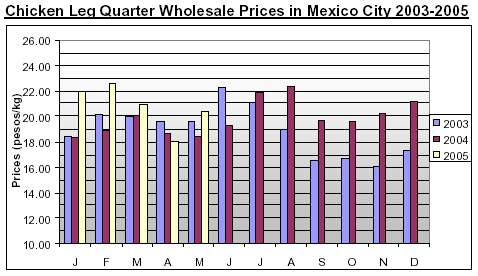



International Egg and Poultry Review: Mexico, the EU and Avian Influenza
US - By the USDA's Agricultural Marketing Service - This is a weekly report looking at international developments concerning the poultry industry, this week looking at Mexico and Avian Influenza and the European Union.
Mexico
Recently Mexico decided to allow imports of raw poultry from the following
US states: California, Connecticut, Delaware, Maryland, Missouri,
New Jersey, North Carolina, Pennsylvania, and Texas beginning
October 4, 2005, according to sources from USA Poultry and Egg
Export Council (USAPEEC.) In return, the US agreed to recognize several
Mexican states as being free of exotic Newcastle disease, pending
a visit from USDA officials in the next week. According to the agreement
reached at a bilateral meeting in Mexico City held to discuss
outstanding technical sanitary issues affecting poultry trade, both countries
will meet again in mid-September to monitor progress of the
agreements. Mexico is the fourth largest importer of US poultry and
purchased US $93 million worth of chicken and related products before
the ban.
On August 9, 2005 both Ciudad Reynosa and Veracruz were eligible to
be border crossing points for frozen chicken leg quarters and bovine
edible offal products. Ciudad Reynosa and Veracruz will be two of
sixteen crossing points and will need to have all imports meet tariff
rate quota (TRQ) specifications and be in accordance with the Secretariat
of Economy. Reynosa has been closed since December 28,
2004 for allowing product to enter the country via amparos (court injunctions,)
a weak loophole in Mexican law allowing any Mexican to
avoid compliance with government rules and regulations, and for allowing
importers to avoid quantitative safeguard limits applying to
chicken leg quarters.
Production
Chicken meat production estimates for 2005 have been slightly reduced,
due to the discovery of Low Pathogenic Avian Influenza in early
March in northern Mexico (La Laguna area in the states of Durango
and Cahuilla,) and the unusual hot temperatures in May and June
affecting bird growth rates. However 2005 production is expected to
recover in the second half of the year. Projections for 2006 show an
increase similar to the last 20 years, due to favorable demand, effective
marketing campaigns, strong financial positions among processors,
and continued quality improvements. Producers also appear to
be benefitting from the trade protection offered by the 2003 safeguard agreement on chicken leg quarters.
Consumptionn
Chicken continues to distance itself from beef and pork in price and
consumption, maintaining its position as Mexico's most affordable
meat protein. Domestic consumption estimates for 2005 have been
lowered, due to reduced supplies and stronger prices. In spite of this,
industry sources expect prices to moderate into the second half of the
year and for consumption near the border to increase, due to more
affordable prices. For May, prices of leg quarters in Mexico City were
about $21 pesos/kg (US$1.89/kg) compared with an average of $11.50
pesos/kg (US$1.03/kg) at the border.
Projections for 2006 show an increase of nearly 5 percent in chicken
meat consumption over 2005 as a result of population growth, the
affordability of chicken in relation to other meats, increased consumer
concerns regarding cholesterol and health issues, effective marketing,
increased usage in processed food products, and improved product
quality. Consumers continue to prefer dark meat to white meat and
fresh whole chicken to parts, though interest in parts is slowly increasing
mainly supermarkets servicing higher-income consumers.
Trade
The US should reach its' TRQ for 2005 (102,010 MT) with Mexico,
despite only filling 85 percent of it in 2004. Imports of cuts, mainly
chicken leg quarters and mechanically separated chicken meat in 2006
are projected to increase five percent over 2005 levels as a result of
increased demand from processors. Interest is growing among importers
to diversify their suppliers and quantities of frozen chicken meat
with other countries, as well as for reduced tariffs and sanitary restrictions
with the potential exporters (i.e. Chile) in the event the US has
another supply disruption. According to the tariff phase-out plan, Mexico
will have duty-free access and eliminate import licenses required for
US leg quarters by January 1, 2008.
Sources: USDA FAS & Various News Wires


Avian Influenza and the European Union
The EU commission convened in Brussels for a meeting of EU veterinary
experts from all Member States to discuss the avian influenza
situation this past week. It was agreed that Member States step up
surveillance, review its' contingency plans, introduce awareness programs,
provide adequate protection to poultry workers, and to consider
flight routes of migratory fowl and vaccinations for at risk areas. However,
a generalized ban on keeping all poultry outdoors was not considered
proportionate to the current risk of disease spreading. A meeting
for early September was scheduled to coordinate more intensified
surveillance for which funding is available.
Sources:Various News Wires
To view the full report, including tables please click here
Source: USDA's Agricultural Marketing Service - 30th August 2005








